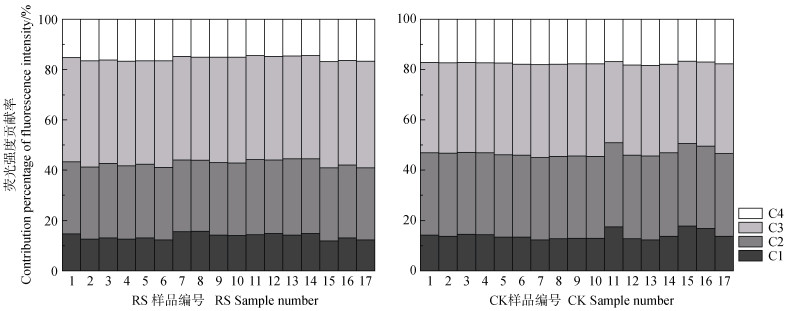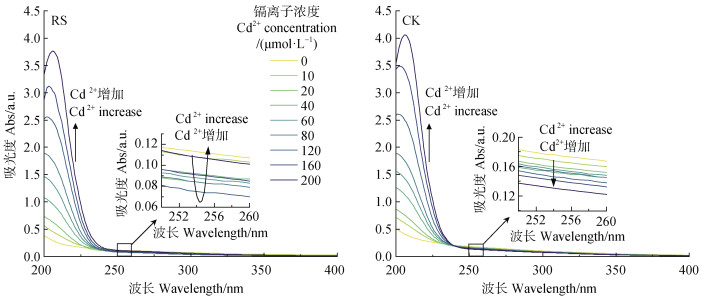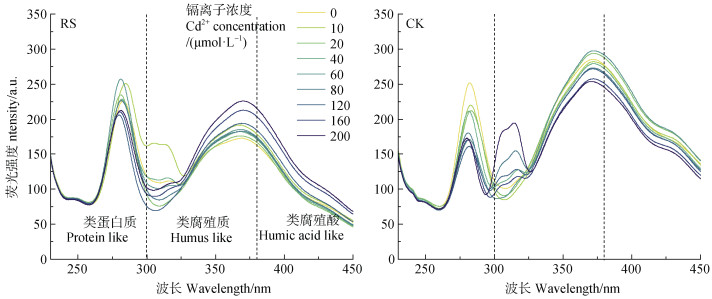2. 江西师范大学生命科学学院/江西省亚热带植物资源保护与利用重点实验室 南昌 330022
2. College of Life Sciences, Jiangxi Normal University/Jiangxi Provincial Key Laboratory of Protection and Utilization of Subtropical Plant Resources, Nanchang 330022, China
稻田是我国最为重要的粮食生产系统之一,目前我国传统水稻单作在稻田系统中占比较高,稻田综合种养是近年来发展较快的复合生态农业模式,是水稻产业的重要组成,其在稻田系统中引入虾、鱼、鸭等进行养殖,以促进农民增收,改善生态环境,但同时也增加了高度淹水、饲料喂养、动物活动等环节,这将改变稻田土壤中的生物化学因子。镉(Cd)是我国农田土壤污染超标率最严重的重金属[1],其具有高迁移性,易富集于植物体内阻碍生长并通过食物链等渠道威胁人类健康。稻田中Cd在土壤和水稻中的积累国内外已有丰富的研究成果,稻田种养过程对Cd的影响方面也有一定研究进展,以我国种养面积最大的稻虾模式为例[2],沈丹琪等[3]研究了稻虾共作模式对土壤和水稻重金属的影响,其结果表明弱酸性土壤背景下稻虾种养显著提高了土壤中Cd的含量,而水稻中Cd的含量有所降低;也有相关研究[4]表明稻虾种养过程中稻田土壤的Cd含量较养殖环沟处土壤高。Cd的迁移与转化受土壤因素影响,如土壤质地[5]、土壤有机质[6]、水分[7]、pH[8]等,而其中稻田土壤的溶解性有机质(Dissolved organic matter,DOM)组分对Cd的影响机理研究现今较少,DOM是有机质中溶于水且能通过0.45 μm滤膜的活性部分,其丰富的酚基、羧基、羟基等官能团对Cd的环境行为影响重大,DOM分子的亲水性和亲电性能使其对Cd吸附,其次还能与Cd形成络合物质、与土壤物质进行离子交换,改变Cd形态,从而影响土壤重金属的迁移和生物有效性[9-10]。稻田种养田间管理措施改变了土壤生化因子,这是否会影响DOM与Cd2+的相互作用机制尚未明晰,探明其中作用机制对稻田土壤系统Cd迁移转化机理研究和防治污染意义重大。
土壤DOM含量和物质组成特征受环境因子影响显著,与稻田中主要水分条件、pH、微生物种群等有关。Li等[11]探究了不同淹水条件对稻田土壤DOM特征的影响,结果表明淹水显著改变了DOM的物质组成特征,芳香性和分子量均随淹水变化而变化;李鸿毅[12]对中国区域水稻土微生物多样性与DOM的关系展开研究,其结果表明环境因子中微生物种群对土壤DOM分子组成特征影响最大,pH与DOM和微生物变化的组成显著相关;Roth等[13]探究了pH与土壤DOM分子组成的关系,其结果表明酸性土壤中DOM通常具有更高的分子量,不同pH的土壤DOM中碳氧结构是控制DOM分子结构的重要因素,较低土壤pH的DOM中酚类化合物含量较高。
土壤中DOM与Cd的相互关系较为密切,林媛等[14]研究了外源DOM对湿地土壤吸附Cd2+的影响,发现腐殖酸对土壤吸附Cd表现为促进作用;罗会龙等[15]研究了稻田土壤DOM光谱特征和水稻Cd累积对不同改良剂的响应,结果表明特定的腐殖质类DOM相对含量与糙米中Cd的累积呈线性相关。不同的DOM组分与Cd2+反应的机制不同,这将影响Cd2+的生物有效性和迁移性,相关研究[16]表明DOM中色氨酸组分的C-O结构与C-N结构更多,对DOM吸附Cd2+具有增强效果,促进其与Cd2+结合稳定性,有利于降低Cd的有效态含量。也有研究表明腐殖质DOM与Cd2+的结合主要受DOM分子量大小和酚基团含量影响[17],腐殖质中高分子量的胡敏酸会与Cd2+形成疏水性物质,抑制Cd2+的流动性和生物有效性[18],而富里酸组分中羧基和酚基官能团具有与Cd2+形成稳定配位键的潜力[19],其与Cd2+的结合提高了Cd的生物有效性。
尽管国内外对DOM的组成变化及其与Cd的相互作用已有一定研究成果,但针对稻田土壤DOM与Cd2+络合过程的相关研究较少,稻田种养增加了不同的田间管理措施如饲养、动物活动等,这些过程改变了田间环境和土壤DOM特征,而对DOM与Cd2+的关系影响如何尚不清晰,相关的对比研究在国内外更是鲜有报道。因此稻田种养对土壤中DOM与Cd2+的相互关系影响值得探究。近年来,紫外-可见吸收光谱和三维荧光、同步荧光光谱广泛应用于表征稻田土壤DOM的变化[20],上述方法均具有对样品量需求少、样品破坏度低、精确度高、方便快捷等特点,其中同步荧光技术对于表征土壤DOM与金属离子间的关系效果较好,这对于稻田土壤DOM与重金属相互关系的研究具有较高的可行性。因此本研究选取水稻单作和稻田种养模式为研究对象,其中稻田种养以我国面积最广的稻虾种养为例,采用紫外-可见吸收光谱、三维荧光光谱和同步荧光光谱、二维相关分析等方法,研究稻田中土壤DOM组成及其与Cd2+的络合过程,可为稻田土壤Cd污染治理和防控提供科学依据。
1 材料与方法 1.1 田间试验与样品采集试验于2022年1-10月在江西省鹰潭市余江区选取平整且土壤性状相对一致、土壤类型为水稻土的田块开展非裂区试验,设置稻虾共作(Integrated rice - shrimp cultivation system,RS)、传统水稻单作(Traditional rice monoculture - Control check,CK)两种模式各两块,面积均大于等于800 m2,管理措施如下:1)稻虾种养设置环沟深约1 m,宽约1.5 m;2)田块利用沟渠引水实现髙灌低排,灌水口和排水口用设置尼龙网和捕鱼笼,水稻单作不设捕鱼笼,其余灌排措施相同;稻虾共作水位保持淹水高于田面约40~60 cm,水稻单作约为20~25 cm;3)稻虾种养过程为2月中旬放虾(375.0 kg·hm-2,虾苗每尾20~25 g),5月上旬收虾并保留部分亲虾,下半年补一季虾苗;6月上旬种稻,并增施有机肥作基肥,其余时间不施肥,每田块播稻种量为22.5 kg·hm-2,环沟不种稻,10月上旬收割,收割前一周放水,稻虾种养田块环沟保留20~25 cm水位以保证虾存活,秸秆实行部分还田;虾苗为克氏原螯虾(Procambarus clarkii,淡水小龙虾),试验稻种为“野香优莉丝”。
研究于水稻成熟期放水后根据网格状采样法使21个样点呈网格点状均匀分布,用不锈钢采土器在每个田块样点对表层土壤(0~20 cm)取柱状样,共取样84(2×2×21)次,每个点采样约200 g,封袋后置于低温箱中运回实验室置于风干架进行自然风干,风干室始终保持通风并避免阳光直射,风干后去除杂质后磨碎混匀,过100目筛后密封保存备用。
1.2 试验方法 1.2.1 DOM样品制备采用水土振荡法提取DOM[21],称取3.0 g风干土样于离心管中,加入60 mL超纯水(Millipore,电阻率18.25 MΩ·cm),于避光且恒温下以200 r·min-1振荡16 h,后经过4 000 r·min-1离心30 min,取上层清液过0.45 μm水系滤膜,得到DOM溶液,封装于避光样品瓶中,置于4 ℃冰箱保存备用,用于光谱测定与实验;为避免内滤效应,已确保所有测试样品UV254<0.3。
1.2.2 荧光猝灭的滴定实验与模型准备数个离心管,每个离心管中注入20 mL DOM溶液,随后向离心管中分别加入不同量0.01 mol·L-1的Cd(NO3)2溶液,使离心管DOM溶液中Cd2+浓度分别为0、10、20、40、60、80、120、160、200 μmol·L-1,所有样品设置3个平行,并利用0.01 mol·L-1的HNO3和NaOH溶液将pH调至6.5±0.2,后将离心管置于避光且恒温下以200 r·min-1振荡24 h,取出后将样品置于4 ℃静置1 h后对样品进行光谱扫描。
1.2.3 土壤理化性质测定pH参照电位法(HJ 962-2018)测定,氧化还原电位(Eh)在成熟期(秋季)利用便携式Eh测试仪(FJA-6,南京传滴仪器)测定,测定深度为5~10 cm;总有机质和有机碳参照重铬酸钾容量法(NY/T 1121.6-2006)测定。溶解性有机碳(Dissolved organic carbon,DOC)用比色法测定,以表示土壤中DOM含量[22]。试验田块土壤样品基础理化性质见下表:
|
|
表 1 稻虾种养(RS)和水稻单作(CK)系统土壤基本性质 Table 1 Soil asic properties in rice-shrimp cultivation(RS)and rice monoculture(CK)systems |
紫外-可见吸收光谱用双光束紫外分光光度计(TU-1900,普析,北京)以步长1 nm进行扫描,范围200~450 nm。三维荧光和同步荧光光谱用荧光分光光度计(F-7100,Hitachi,日本)扫描,参数设置如下:1)三维荧光光谱:发射波长(Em)为250~550 nm,激发波长(Ex)230~450 nm,步长5 nm,光电倍增管(PMT)电压为700 V,扫描速度12 000 nm·min-1;2)同步荧光光谱:Ex为230~450 nm,步长5 nm,PMT电压为700 V,扫描速度为240 nm·min-1。
1.4 数据处理与分析 1.4.1 紫外吸收光谱与参数紫外光谱利用Origin 2022软件绘图;UV254值是波长254 nm处DOM的吸光度,指示DOM的芳香性和腐殖化程度,值越高芳香度和腐殖化程度越高[23]。
1.4.2 平行因子分析平行因子分析法(Parallel factor analysis,PARAFAC)能够将荧光光谱中的信号矩阵分解为多个荧光团信息,可鉴定样品中的物质组分类型;使用MATLAB R2022a中DOMFluor工具箱对荧光光谱进行平行因子分析,数据在分析建模前进行拉曼单位化处理、去除异常值等处理;建模组分模型通过拆半分析验证后,上传至OpenFluor在线数据库中比较,以鉴别DOM物质类型与特征。
1.4.3 二维相关光谱分析二维相关光谱(2D-COS)可表征有机物质受外界扰动所引起的变化特征,有助于提高光谱辨析度,辨别不同物质峰在扰动过程中的相互关系,同时可对扰动因素与DOM的络合反应顺序进行分析。本研究使用2D-Shige软件和Origin 2022软件进行分析并绘制二维相关光谱。
1.4.4 络合反应模型修正型Stern-Volmer模型对有机物与重金属的静态猝灭过程具有良好的表征拟合效果[24],公式如下:
| $ {F_{\text{0}}}{\text{/(}}{F_{\text{0}}} - F{\text{) = 1/(}}fk{\text{[}}Cd{\text{]) + 1/}}f $ | (1) |
式中,F为猝灭后DOM的荧光强度,F0为DOM原始荧光强度,k为络合稳定常数,f为参与配位的荧光基团比例,K和f通过回归计算拟合获得,对K取对数lg K即为络合稳定常数。
2 结果 2.1 土壤DOM组分变化特征对2种稻田系统的84个土壤DOM样品的三维荧光光谱进行平行因子分析,建模解析均得到蛋白质组分1个和腐殖质类组分3个,各组分荧光峰见图 1,水稻单作系统(CK)和稻虾种养系统(RS)的土壤DOM组成物质相似,特征如下:组分C1荧光峰位于λEm= 350 nm,λEx=280 nm,属于蛋白质中的类色氨酸物质,该物质与微生物活动较为密切[25];C2荧光峰位于λEm= 325 nm,λEx=400 nm,属典型的腐殖质类物质,常见于淡水水系和植物生长的陆地土壤,其分子量相对较小,具有相对较高的芳香性和腐殖化程度[26];C3荧光峰位于λEm= 445 nm,λEx=275/365 nm,是常见的土壤腐殖类物质,植物源特性较明显,是与木质素相关的组分[27];C4荧光峰位于λEm= 490 nm,λEx=285/370 nm,是土壤中常见的富里酸物质,具有较高的分子量[28]。

|
注:C1表示第1组分,“C”即为Component,C2~C4含义同理。 Note: C1 represents the number 1 Component, "C" is the component, C2, C3 and C4 have similar ways. 图 1 稻虾种养(RS)和水稻单作系统(CK)的4种溶解性有机质(DOM)荧光组分 Fig. 1 Four dissolved organic matter(DOM)fluorescence components in RS and CK systems |
荧光强度贡献率可表征各个组分在DOM物质中的相对含量比例[29]。两种稻田系统土壤DOM组分的荧光强度贡献率如图 2所示,在RS和CK中,组分C1的贡献率相近,无显著性差异,其他组分在两种模式中均存在显著性差异,C2和C4组分占比表现为:CK>RS,而C3组分占比表现为:RS>CK(P<0.05)。由此可知,稻田土壤DOM主要物质为腐殖质,RS土壤DOM的物质组成比例与CK不同。

|
注:图中数据为每2个土壤样品取平均值,并去除了异常值样品。 Note: The data in the figure were averaged for every 2 soil samples, and the outlier samples were removed. 图 2 稻虾种养(RS)和水稻单作(CK)系统土壤DOM各组分荧光强度贡献率 Fig. 2 Contribution percentage of fluorescence intensity of soil DOM components in RS and CK systems |
为探究DOM变化后其与Cd2+的络合过程,利用荧光猝灭滴定实验展开研究。DOM与Cd2+猝灭反应的紫外吸收光谱如图 3所示,在RS和CK中,随着Cd2+增加,紫外光谱200~240 nm处的吸光度逐渐增加,240 nm之后吸光度逐渐趋于0;UV254是表征DOM芳香度的重要参数,值越大DOM芳香度越高,本研究UV254在猝灭过程中的变化微弱,在RS中,随着Cd2+浓度的增加,UV254先下降后上升,而在CK中UV254随着Cd2+浓度的上升而下降,可知Cd2+增加导致DOM特征的改变,因此Cd2+显著改变了DOM的紫外吸收光谱,说明DOM与Cd2+猝灭过程为静态猝灭[30]。

|
注:箭头所指方向为Cd2+浓度上升后光谱曲线的变化方向。 Note: The direction indicated by the arrow is the change direction of the spectral curve after the Cd2+ concentration increases 图 3 稻虾种养(RS)和水稻单作(CK)系统土壤DOM与Cd2+猝灭反应的紫外吸收光谱 Fig. 3 UV absorption spectra of soil DOM and Cd2+quenching reactions in RS and CK systems |
土壤DOM与Cd2+反应的猝灭同步荧光光谱如图 4所示,250 ~300 nm处激发峰来源于类蛋白质,300~380 nm处的激发峰来源于腐殖质,380~450 nm处激发峰来源于腐殖酸;类蛋白质随着Cd2+含量增加,荧光强度呈下降趋势,可判断为色氨酸物质与Cd2+发生的荧光猝灭现象;RS在310 nm处腐殖质峰随着Cd2+增加无明显规律性,而CK则发生了荧光猝灭;370~380 nm处的腐殖质其荧光峰在RS发生荧光猝灭,而CK的荧光强度则先增后降。

|
图 4 稻虾种养(RS)和水稻单作(CK)系统土壤DOM与Cd2+猝灭反应的同步荧光光谱 Fig. 4 Synchronous fluorescence spectra of soil DOM and Cd2+ quenching reactions in RS and CK systems |
二维相关光谱可分辨两种物质之间的反应变化。RS和CK土壤DOM的同步图和异步图如图 5所示:在CK同步图中,发现3个自动峰(284/ 284 nm、310/310 nm、375/375 nm),对应色氨酸组分和两个腐殖质类组分;而在RS同步谱中,发现4个自动峰(270/270 nm、290/290 nm、310/310 nm、375/375 nm);色氨酸和腐殖质(310 nm)荧光强度更高,荧光强度CK大于RS,说明该两种物质对Cd2+的浓度变化响应更强,CK的DOM对Cd2+的变化响应更强;370~380 nm处的自动峰荧光强度表现为:RS>CK,说明在RS中腐殖质DOM对于Cd2+响应更强。RS中存在4个负交叉峰位于290/270 nm、310/270 nm、375/290 nm、375/310 nm,2个正交叉峰位于310/290 nm、375/270 nm;CK中可发现2个负交叉峰310/284 nm、375/310 nm和一个正交叉峰375/284 nm。同步图交叉峰结合异步图可揭示Cd2+与DOM的络合顺序,在异步图中,RS发现3个正交叉峰(310/290 nm、375/290 nm、375/310 nm)和2个负交叉峰(310/270 nm、375/270 nm),CK发现1个正交叉峰(310/284 nm)和2个负交叉峰(375/284 nm、375/310 nm)。根据Noda法则[31],DOM在RS与Cd2+的络合顺序为:310 nm>270 nm= 290 nm>375 nm,即依次为腐殖质(310nm)、色氨酸、腐殖质(375 nm);在CK中则为:284 nm>375 nm>310 nm;即依次为色氨酸、腐殖质(375 nm)、腐殖质(310nm),表明稻田土壤DOM与Cd2+的络合顺序在不同的田块处理间有所差异。

|
图 5 稻虾种养(RS)和水稻单作(CK)系统土壤DOM与Cd2+猝灭反应的同步和异步图 Fig. 5 Synchronous and asynchronous plots of soil DOM and Cd2+ quenching reactions in RS and CK systems |
为分析各DOM组分与Cd2+的络合能力,利用修正型Stern-Volmer模型结合DOM猝灭后的荧光强度进行拟合分析DOM组分与Cd2+的络合能力。在RS和CK中,色氨酸组分C1和富里酸组分C4荧光强度均随Cd2+的增加呈先降低后稳定的现象(图 6),表明发生了荧光猝灭;而C2和C3的变化不稳定且无显著规律(图 6)。络合常数lgK用于表征重金属与DOM的络合能力[32],DOM与Cd2+反应的络合常数lg K见表 2。两种稻田系统中,C1和C4发生的猝灭反应均能够被修正型Stern-Volmer模型拟合,腐殖质组分C2和C3拟合失败。C1和C4的lg K在RS中分别为4.25、5.03,CK中分别为3.95、4.10,成功拟合的lg K值中RS>CK。

|
图 6 稻虾种养(RS)和水稻单作(CK)系统土壤DOM各组分与Cd2+猝灭反应的荧光强度变化 Fig. 6 Changes in fluorescence intensity of soil DOM components and Cd2+ quenching reaction in RS and CK systems |
|
|
表 2 稻虾种养(RS)和水稻单作(CK)系统土壤DOM中C1和C4组分与Cd2+络合作用相关参数 Table 2 Parameters related to the complexation between soil DOM components and Cd2+ in RS and CK systems |
DOM组分的比例结构影响着其与重金属的作用关系,本研究RS的土壤DOM组分组成与CK相同(图 1),但各组分所占比例不同(图 2),这与恒湖地区的研究结果[33]相似,主要与淹水、生物活动等条件差异有关,虾的挖洞行为穿透稻田土壤的表层和底层,增加了土壤渗透性和水分迁移通道,使营养物质和氧气到达底层,最终影响土壤微生物群落结构变化和DOM随水分迁移,影响DOM产生组成[34];就DOM物质组成比例而言,低分子量C2在RS中平均占比较CK低,这很可能与分子量大小和淹水条件有关,相比CK,RS淹水深度更高、生物活动强度更大,低分子量的DOM在其中易迁移流失,向水中释放以及生物分解的程度更高,因此RS的C2占比例较少[35];C3是与木质素分解相关的腐殖质,其在RS占比相对较高,说明与水稻种植和代谢物分解有关,因为与CK相比,RS的水稻种植密度在相同面积下更高,根际代谢物可转化为更多DOM物质,且根际附近土壤DOM受微生物活动影响更大,RS微生物群落丰度和活性更高,进而微生物对木质素向DOM分解转化的速率更高[36],这可能是本研究中C3在RS中比例较高的重要原因。
3.2 紫外光谱与同步荧光光谱对DOM与Cd2+猝灭反应的指示意义紫外光谱显示DOM吸收峰主要位于200~220 nm处,随Cd2+浓度增加吸收曲线有所红移(图 3),说明吸收峰主要来自羧基团和共轭体系结构、芳香结构物质;本研究中UV254变化微弱(图 3),说明土壤DOM与Cd2+的络合能力弱,侧面反映出Cd2+在土壤中的不稳定性和强迁移性。就同步荧光曲线(图 4)而言,270 nm处类蛋白质在RS土壤中与Cd2+的络合反应较CK更稳定,而300~325 nm处的腐殖质荧光强度随着Cd2+增加在CK和RS均无显著规律,表明腐殖质与Cd2+的络合能力并不稳定,环境条件影响、物质争夺络合点位、其他可溶于水的土壤物质与Cd2+的络合,均会引起荧光强度不稳定[37],与CK相比,RS的土壤Eh较低、DOC含量较高(表 1),说明RS的土壤环境更倾向还原性,与CK差异显著,且淹水和虾的饲养干扰使环境条件改变,DOM来源增多,DOM的物质组成比例也改变,影响其与Cd2+的络合。
3.3 2D-COS对DOM与Cd2+猝灭反应的指示意义就络合顺序而言,CK中色氨酸组分优先与Cd2+络合,而RS中腐殖质组分与Cd2+优先络合,二者的DOM与Cd2+的络合顺序差异明显(图 5),说明DOM在两种稻田土壤中与Cd2+的络合并不稳定。相比其他重金属,Cd2+与DOM的亲和力较低,这影响了Cd与DOM的配位点竞争力,干扰了DOM与Cd2+的络合稳定性[38]。其次,DOM与Cd2+的络合一定程度上取决于DOM的组成和结构,芳香结构较多的DOM,由于丰富的羧基与Cd2+的络合具有较高的亲和力和强干扰性,同时芳香结构通常具有不饱和共轭键等不稳定结构,容易发生自由基反应和裂解反应,这影响Cd2+和DOM的络合稳定性[39],本研究中类腐殖质在DOM中占主要比例(图 2),具有较多芳香性结构,如高芳香度的C2在稻田土壤DOM占比均较大,C3作为木质素相关组分也具有高芳香性的特征,会优先被土壤吸附[20],因此腐殖质DOM与Cd2+的络合并不稳定。
DOM在两种模式中与Cd2+的络合顺序差异可能与DOM的浓度及其共轭结构、羧基等物质含量差异等有关,即使相同的物质组分,受DOM浓度和金属络合点位分布差异的影响,其与Cd2+的亲和力也不同,各官能团含量差异也会影响DOM与Cd2+的络合能力和稳定性,CK和RS土壤DOM在物质比例上有差异(图 2),因此共轭结构和含氮氧元素的羧基、聚多肽物质等含量不同,进而影响DOM与Cd2+的络合能力。综上述可得出,DOM的物质构成比例差异很有可能是造成不同稻田系统土壤腐殖质与Cd2+络合能力差异的主要原因。稻田种养土壤DOM的浓度比例与分子结构组成差异主要受淹水条件、微生物活动等影响[33],而淹水和生物活动对DOM的影响,主要通过水的溶解和流动迁移、生物活动代谢以及微生物分解等产生。综上所述可判断,稻田种养通过淹水条件和生物群落活动间接影响了土壤DOM分子与Cd2+的络合能力与顺序。
3.4 络合反应模型对DOM组分与Cd2+猝灭反应的指示意义络合反应模型中C1和C4成功被拟合(表 2),表明二者与Cd2+络合相对稳定,络合常数lg K均在RS中较高,表明RS中DOM与Cd2+的络合能力更强,相关研究表明淹水和高浓度的DOM可提高土壤中DOM与Cd2+的络合能力[11]。本研究DOM含量在RS较高(表 1),且RS淹水水位较高,这很有可能是RS的土壤DOM与Cd2+络合能力强于CK的原因。色氨酸DOM中C-O结构与C-N结构更多[16],有利于其与Cd2+吸附结合的稳定性,这可能是本研究中C1与Cd2+离子络合稳定的重要原因,这有利于降低土壤中Cd的有效性。富里酸组分C4相对lgK值较色氨酸组分C1高(表 2),表明富里酸与Cd2+的络合能力较色氨酸类强,富里酸C4具有较高的分子量,其结构含有大量羧基和酚羟基,阳离子交换量高,容易与Cd2+形成强键[40],这是本研究中C4与Cd2+络合能力较强且稳定的重要原因,但是RS富里酸C4与Cd2+的结合能力增强的同时也增强了土壤中Cd的生物有效性和迁移性,尽管RS中C4比例相对CK稍低(图 2),但也应在稻田种养过程中注重Cd迁移污染风险。猝灭过程中C2和C3荧光强度变化不稳定,无法被修正型Stern-Volmer模型拟合(图 6),表明腐殖质DOM与Cd2+络合的不稳定性和复杂性,Cd2+与DOM的络合顺序在RS和CK中不同也体现了该观点,这佐证了腐殖质组分对DOM与Cd2+络合稳定的干扰与DOM的高芳香性结构物质密切相关,除此还可能与Cd2+的高迁移率、DOM的特征差异性有关[38],Cd2+与C2和C3络合的不稳定性,不利于Cd2+的污染防治,说明稻田土壤中Cd污染迁移的风险也需警惕防范。
4 结论本研究联合多光谱技术耦合平行因子、二维相关分析和络合反应模型,解析了稻田土壤DOM与Cd2+的络合过程。平行因子分析表明两种稻田系统土壤DOM主要组成物质相同,但土壤DOM各组分所占比例不同。二维相关分析表明在稻田种养的土壤中,Cd2+与DOM的络合顺序显著不同,这与DOM中存在大量的高芳香结构有关,也导致腐殖质DOM与Cd2+的络合在两种稻田系统具有不稳定性和复杂性。络合反应模型表明稻田种养土壤中色氨酸和富里酸DOM与Cd2+的络合能力较水稻单作强,富里酸DOM与Cd2+的络合能力较色氨酸DOM强;富里酸与Cd2+结合可增强Cd的生物有效性。综上所述,稻田种养在一定程度上不利于土壤吸附稳定Cd2+,在田间实践需警惕Cd2+污染和迁移风险,该结果可为稻田土壤Cd的污染防治提供科学参考。
| [1] |
Ministry of Environmental Protection, Ministry of Land and Resources. National soil pollution status survey bulletin[R]. Beijing: Ministry of Environmental Protection, 2014.[环境保护部, 国土资源部. 全国土壤污染状况调查公报[R]. 北京: 环境保护部, 2014.]
(  0) 0) |
| [2] |
Yu X J, Hao X J, Dang Z Q, et al. Development report on the integrated cultivation and breeding industry of rice and fish in China(2023) (In Chinese)[J]. China Fisheries, 2023(8): 19-26. [于秀娟, 郝向举, 党子乔, 等. 中国稻渔综合种养产业发展报告(2023)[J]. 中国水产, 2023(8): 19-26.]
(  0) 0) |
| [3] |
Shen D Q, Liu M, Cao C G, et al. Effects of pH on heavy metals contents in paddy soil and rice under rice-crayfish co-culture (In Chinese)[J]. Journal of Huazhong Agricultural University, 2023, 42(2): 86-92. [沈丹琪, 刘敏, 曹凑贵, 等. 稻虾共作模式下稻田pH对土壤和水稻重金属含量的影响[J]. 华中农业大学学报, 2023, 42(2): 86-92.]
(  0) 0) |
| [4] |
Yin S H, Huang H B, Dai P, et al. Analysis of changes in water quality and soil heavy metals of rice and shrimp fields in Binhai (In Chinese)[J]. Journal of Aquaculture, 2023, 44(8): 24-28. [尹思慧, 黄鸿兵, 代培, 等. 稻虾综合种养田水质与土壤重金属含量分析[J]. 水产养殖, 2023, 44(8): 24-28.]
(  0) 0) |
| [5] |
Sun Q C, Wang X D, Qiao J C, et al. Study on Cd adsorption characteristics and influencing factors of soils with different textures (In Chinese)[J]. Soils, 2020, 52(3): 545-551. [孙庆超, 王旭东, 乔建晨, 等. 不同质地土壤对镉的吸附特性及影响因子研究[J]. 土壤, 2020, 52(3): 545-551.]
(  0) 0) |
| [6] |
Mei X, Liu H Y, Wu L H, et al. Spatial distribution of soil heavy metals and influencing factors in northwest of Guizhou based on HDXRF and ICP-MS (In Chinese)[J]. Soils, 2023, 55(2): 399-408. [梅雪, 刘鸿雁, 吴龙华, 等. 基于HDXRF和ICP-MS的黔西北土壤重金属空间分布及影响因素研究[J]. 土壤, 2023, 55(2): 399-408.]
(  0) 0) |
| [7] |
Zhang Y T, Zhu Q H, Huang D Y, et al. Effects of drying and oxidation stage on the forms and availability of Cd and As in the soil-rice system (In Chinese)[J]. Acta Pedologica Sinica, 2023, 60(2): 446-457. [张雨婷, 朱奇宏, 黄道友, 等. 落干过程对土壤-水稻系统镉和砷形态及有效性的影响[J]. 土壤学报, 2023, 60(2): 446-457.]
(  0) 0) |
| [8] |
Li J, Lin Q, Xu S H. Desorption and migration characteristics of Cu/Cd composite contaminated soil under different pH/ionic strength (In Chinese)[J]. Acta Pedologica Sinica, 2023, 60(4): 1026-1034. [李静, 林青, 徐绍辉. 不同pH/离子强度时Cu/Cd复合污染土壤解吸和迁移特征[J]. 土壤学报, 2023, 60(4): 1026-1034.]
(  0) 0) |
| [9] |
Ye Q T, Ding Z C, Li R, et al. Kinetics of cadmium(Cd), nickel(Ni), and lead(Pb)release from fulvic acid: Role of re-association reactions and quantitative models[J]. Science of the Total Environment, 2022, 843: 156996. DOI:10.1016/j.scitotenv.2022.156996
(  0) 0) |
| [10] |
Gong H F, Chi J. Contribution of different mechanisms to Pb2+ and Cd2+ sorption on magnetic wheat straw biochars: Impact of pyrolysis temperature and DOM in biochar[J]. Journal of Environmental Chemical Engineering, 2022, 10(3): 107851. DOI:10.1016/j.jece.2022.107851
(  0) 0) |
| [11] |
Li Z W, Huang M, Luo N L, et al. Spectroscopic study of the effects of dissolved organic matter compositional changes on availability of cadmium in paddy soil under different water management practices[J]. Chemosphere, 2019, 225: 414-423. DOI:10.1016/j.chemosphere.2019.03.059
(  0) 0) |
| [12] |
Li H Y. Microbial ecological diversity of paddy soil in typical areas of China and its ecological correlation with chemical diversity of dissolved organic matter[D]. Hangzhou: Zhejiang University, 2018.[李鸿毅. 中国典型区域水稻土微生物生态多样性及其与溶解性有机质化学多样性的生态关联[D]. 杭州: 浙江大学, 2018.]
(  0) 0) |
| [13] |
Roth V N, Dittmar T, Gaupp R, et al. The molecular composition of dissolved organic matter in forest soils as a function of pH and temperature[J]. PLoS One, 2015, 10(3): e0119188. DOI:10.1371/journal.pone.0119188
(  0) 0) |
| [14] |
Lin Y, Gong X F, Xiong J Q, et al. Effects of DOM on the wetland soils adsorption of heavy metals Pb2+ and Cd2+ (In Chinese)[J]. Journal of Nanchang University(Natural Science), 2021, 45(1): 71-78. [林媛, 弓晓峰, 熊捷迁, 等. 外源DOM对湿地土壤吸附重金属Pb2+、Cd2+的影响[J]. 南昌大学学报(理科版), 2021, 45(1): 71-78.]
(  0) 0) |
| [15] |
Luo H L, Chen J, Zhang Y H, et al. Responses of Cd accumulation in rice and spectral characteristics of soil dissolved organic matter regulated by soil amendments (In Chinese)[J]. Environmental Science, 2022, 43(6): 3315-3327. [罗会龙, 陈娟, 张云慧, 等. 改良剂调控下水稻镉累积和土壤溶解性有机质光谱特征的响应[J]. 环境科学, 2022, 43(6): 3315-3327.]
(  0) 0) |
| [16] |
Chen L Y, Lian Z Y, Song W F, et al. Coercive effects of different exogenous Cd(Ⅱ)on Pseudomonas aeruginosa EPS--Changes in yield, composition, adsorption characteristics and their mechanisms (In Chinese)[J]. China Environmental Science, 2024, 44(1): 537-547. [陈丽瑶, 连泽阳, 宋卫锋, 等. 不同外源Cd(Ⅱ)对Pseudomonas aeruginosa EPS的胁迫效应--产量、组分、吸附特性变化及其机制[J]. 中国环境科学, 2024, 44(1): 537-547.]
(  0) 0) |
| [17] |
Bai H C, Jiang Z M, He M J, et al. Relating Cd2+ binding by humic acids to molecular weight: A modeling and spectroscopic study[J]. Journal of Environmental Sciences, 2018, 70(8): 154-165.
(  0) 0) |
| [18] |
Chotpantarat S, Chunhacherdchai L, Wikiniyadhanee R, et al. Effects of humic acid amendment on the mobility of heavy metals(Co, Cu, Cr, Mn, Ni, Pb, and Zn)in gold mine tailings in Thailand[J]. Arabian Journal of Geosciences, 2015, 8(9): 7589-7600. DOI:10.1007/s12517-014-1750-y
(  0) 0) |
| [19] |
Rashid I, Murtaza G, Dar A A, et al. The influence of humic and fulvic acids on Cd bioavailability to wheat cultivars grown on sewage irrigated Cd-contaminated soils[J]. Ecotoxicology and Environmental Safety, 2020, 205: 111347. DOI:10.1016/j.ecoenv.2020.111347
(  0) 0) |
| [20] |
Yang G, Tang X Y, Guan Z, et al. Effects of straw return and moisture condition on temporal changes of DOM composition and Cd speciation in polluted farmland soil[J]. International Journal of Environmental Research and Public Health, 2022, 19(19): 12128. DOI:10.3390/ijerph191912128
(  0) 0) |
| [21] |
Fan T T, Yao X, Sun Z L, et al. Properties and metal binding behaviors of sediment dissolved organic matter(SDOM)in lakes with different trophic states along the Yangtze River Basin: A comparison and summary[J]. Water Research, 2023, 231: 119605. DOI:10.1016/j.watres.2023.119605
(  0) 0) |
| [22] |
Zhan X H, Zhou L X. Colorimetric determination of dissolved organic carbon in soil solution and water environment (In Chinese)[J]. China Environmental Science, 2002, 22(5): 433-437. [占新华, 周立祥. 土壤溶液和水体中水溶性有机碳的比色测定[J]. 中国环境科学, 2002, 22(5): 433-437.]
(  0) 0) |
| [23] |
Nishijima W, Jr Speitel G E. Fate of biodegradable dissolved organic carbon produced by ozonation on biological activated carbon[J]. Chemosphere, 2004, 56(2): 113-119. DOI:10.1016/j.chemosphere.2004.03.009
(  0) 0) |
| [24] |
Hays M D, Ryan D K, Pennell S. A modified multisite Stern-Volmer equation for the determination of conditional stability constants and ligand concentrations of soil fulvic acid with metal ions[J]. Analytical Chemistry, 2004, 76(3): 848-854. DOI:10.1021/ac0344135
(  0) 0) |
| [25] |
Osburn C L, Handsel L T, Peierls B L, et al. Predicting sources of dissolved organic nitrogen to an estuary from an agro-urban coastal watershed[J]. Environmental Science & Technology, 2016, 50(16): 8473-8484.
(  0) 0) |
| [26] |
Yamashita Y, Cory R M, Nishioka J, et al. Fluorescence characteristics of dissolved organic matter in the deep waters of the Okhotsk Sea and the northwestern North Pacific Ocean[J]. Deep Sea Research Part Ⅱ, 2010, 57(16): 1478-1485. DOI:10.1016/j.dsr2.2010.02.016
(  0) 0) |
| [27] |
Gullian-Klanian M, Gold-Bouchot G, Delgadillo-Díaz M, et al. Effect of the use of Bacillus spp. on the characteristics of dissolved fluorescent organic matter and the phytochemical quality of Stevia rebaudiana grown in a recirculating aquaponic system[J]. Environmental Science and Pollution Research International, 2021, 28(27): 36326-36343. DOI:10.1007/s11356-021-13148-6
(  0) 0) |
| [28] |
Søndergaard M, Stedmon C A, Borch N H. Fate of terrigenous dissolved organic matter(DOM)in estuaries: Aggregation and bioavailability[J]. Ophelia, 2003, 57(3): 161-176. DOI:10.1080/00785236.2003.10409512
(  0) 0) |
| [29] |
Chen L M, Wu Y Y, Li C S, et al. Molecular characteristics of soil dissolved organic matter in response to decomposition of organic fertilizers from different sources (In Chinese)[J]. Acta Pedologica Sinica, 2023, 60(4): 1101-1112. [陈丽铭, 吴月颖, 李财生, 等. 土壤溶解性有机质分子特征对不同来源有机肥分解的响应[J]. 土壤学报, 2023, 60(4): 1101-1112.]
(  0) 0) |
| [30] |
Xu J, Sheng G P, Ma Y, et al. Roles of extracellular polymeric substances(EPS)in the migration and removal of sulfamethazine in activated sludge system[J]. Water Research, 2013, 47(14): 5298-5306. DOI:10.1016/j.watres.2013.06.009
(  0) 0) |
| [31] |
Noda I, Ozaki Y. Two-dimensional correlation spectroscopy: Applications in vibrational and optical spectroscopy . Hoboken, NJ: Wiley, 2004.
(  0) 0) |
| [32] |
Huang Y, Tian Y Y, Xie L H, et al. The application of two-dimensional correlation spectroscopy for the binding properties of heavy metals onto digestate-derived DOM from anaerobic digestion of chicken manure[J]. Ecotoxicology and Environmental Safety, 2020, 204: 111129. DOI:10.1016/j.ecoenv.2020.111129
(  0) 0) |
| [33] |
Liang Y H, Ni C Y, Liu X X, et al. Spectral characteristics of soil dissolved organic matter in different rice-crayfish cultivation modes (In Chinese)[J]. Chinese Journal of Eco-Agriculture, 2023, 31(4): 543-557. [梁以豪, 倪才英, 刘星星, 等. 不同稻虾种养模式土壤溶解性有机质光谱特征[J]. 中国生态农业学报, 2023, 31(4): 543-557.]
(  0) 0) |
| [34] |
Yan S S, Song J M, Fan J S, et al. Changes in soil organic carbon fractions and microbial community under rice straw return in Northeast China[J]. Global Ecology and Conservation, 2020, 22: e00962. DOI:10.1016/j.gecco.2020.e00962
(  0) 0) |
| [35] |
Li C S, Wu Y Y, Chen L M, et al. Size fraction distribution and spectral characteristics of dissolved organic matter derived from different organic fertilizers (In Chinese)[J]. Journal of Plant Nutrition and Fertilizers, 2022, 28(6): 961-971. [李财生, 吴月颖, 陈丽铭, 等. 不同来源有机肥释放的溶解有机质粒径分布与光谱特征[J]. 植物营养与肥料学报, 2022, 28(6): 961-971.]
(  0) 0) |
| [36] |
Lai Z, Xiao L T, Lai S, et al. Effects of a new rice-shrimp farming model on soil fertility and microbial community structure in paddy field (In Chinese)[J]. Acta Pedologica Sinica, 2023, 60(6): 1790-1800. [赖政, 肖力婷, 赖胜, 等. 稻虾种养新模式对稻田土壤肥力和微生物群落结构的影响[J]. 土壤学报, 2023, 60(6): 1790-1800.]
(  0) 0) |
| [37] |
Ren H Y, Ma F Y, Yao X, et al. Multi-spectroscopic investigation on the spatial distribution and copper binding ability of sediment dissolved organic matter in Nansi Lake, China[J]. Journal of Hydrology, 2020, 591: 125289. DOI:10.1016/j.jhydrol.2020.125289
(  0) 0) |
| [38] |
Huang M, Li Z W, Huang B, et al. Investigating binding characteristics of cadmium and copper to DOM derived from compost and rice straw using EEM-PARAFAC combined with two-dimensional FTIR correlation analyses[J]. Journal of Hazardous Materials, 2018, 344: 539-548. DOI:10.1016/j.jhazmat.2017.10.022
(  0) 0) |
| [39] |
Cornu J Y, Schneider A, Jezequel K, et al. Modelling the complexation of Cd in soil solution at different temperatures using the UV-absorbance of dissolved organic matter[J]. Geoderma, 2011, 162(1/2): 65-70.
(  0) 0) |
| [40] |
Zhang X Q, Li Y, Ye J, et al. The spectral characteristics and cadmium complexation of soil dissolved organic matter in a wide range of forest lands[J]. Environmental Pollution, 2022, 299: 118834. DOI:10.1016/j.envpol.2022.118834
(  0) 0) |
 2025, Vol. 62
2025, Vol. 62


